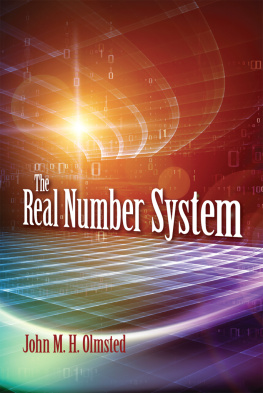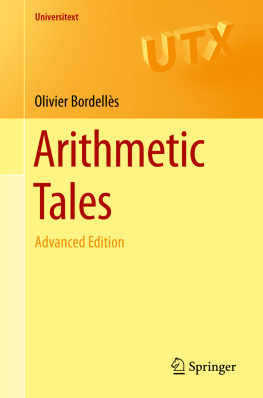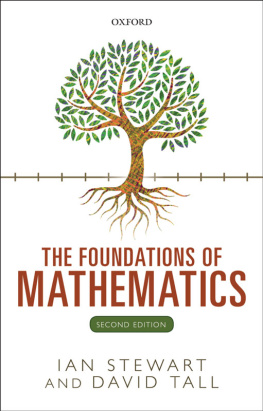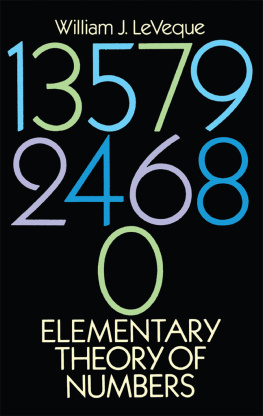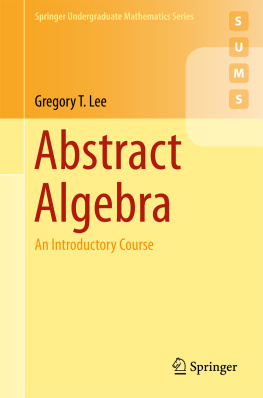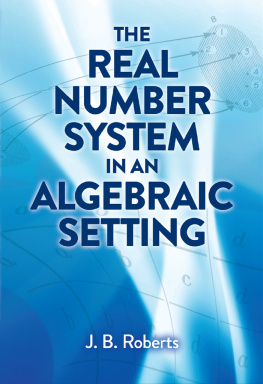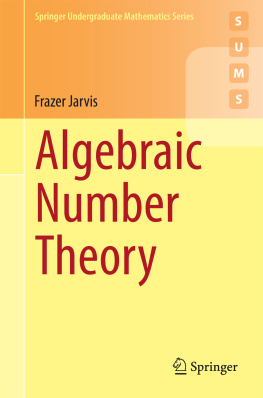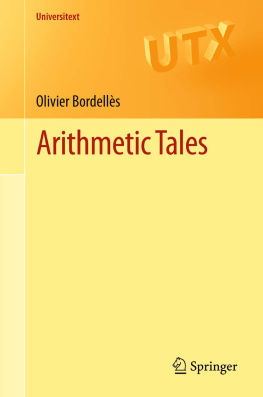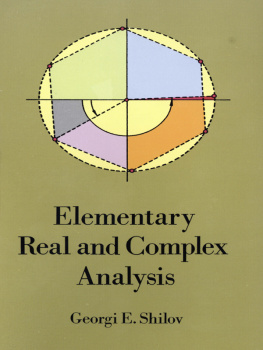The
Real Number
System
John M. H. Olmsted
Dover Publications, Inc.
Mineola, New York
Bibliographical Note
This Dover edition, first published in 2018, is an unabridged republication of the work originally published in the Appleton-Century Monographs in Mathematics series by Appleton-Century-Crofts, a division of Meredith Publishing Company New York, in 1962.
Library of Congress Cataloging-in-Publication Data
Names: Olmsted, John M. H. (John Meigs Hubbell), 1911-1997, author.
Title: The real number system / John M. H. Olmsted.
Description: Dover edition. | Mineola, New York : Dover Publications, 2018. | Originally published: New York, N.Y. : Appleton-Century-Crofts, 1962. | Includes index.
Identifiers: LCCN 20180095721 ISBN 9780486827643 | ISBN 048682764X
Subjects: LCSH: Numbers, Real. | Numbers, RealProblems, exercises, etc.
Classification: LCC QA255 .43 2018 | DDC 512.7/86dc23
LC record available at https://lccn.loc.gov/2018009572
Manufactured in the United States by LSC Communications
82764X01 2018
www.doverpublications.com
PREFACE
T HE NUMBERS THAT CONSTITUTE what is known as the real number system are basic to all of mathematics and hence to all of science. These are the numbers of the everyday world as well, some being used by the nursery child in counting piles of blocks, some by the carpenter in measuring lengths and areas, and some by the banker in reckoning profits, losses, and percentages. Properties of the real numbers permeate our culture and are used almost universally, to a varying extent and with a varying degree of explicit awareness on the part of the user. Questions naturally formulate themselves. Why are these properties true? Where do they come from? What other properties do the real numbers have? Just what is a real number anyway?
The present volume tells about real numbers by investigating the kind of structure that is formed by the totality of all real numbers. The real number system is described categorically in the book by a set of axioms, stated briefly: the real number system is a complete ordered field. These axioms are presented and studied step by step, with numerous examples used to illustrate the new concepts as they are introduced. Examples of ordered fields that are not complete, fields that are not ordered, and systems that are similar to fields but are not fields are all examined with a view to an increased understanding of the real number system itself. The discussion is extensive and multiple-leveled, and is designed for more than one particular audience. As a monograph the book attempts to tell a fairly full story, including much about induction and going all the way to the laws of exponents for arbitrary positive bases and real exponents. An appendix shows how the property of completeness can be described in a large number of equivalent fashions.
A continuous effort is made to communicate to educated laymen as much of the spirit and content of the particular axiomatic system to which the book is dedicated as is consistent with the readers mathematical backgrounds and tastes. The discussion and proofs throughout the book are kept on as elementary a level as possible. Logical ideas are discussed in context as they arise. For example, the precise meaning of the implication p implies q and and becoming more frequent as he progresses. With effort and concentration, however, anyone with a year or so of high school mathematics and a healthy ambition should be able to work his way steadily through to the Appendix. (The Appendix is another matter, demanding a considerable background of college mathematical analysis.)
The book may be used as a text on any of several levels. The first two chapters are at an Elementary level (high school seniors and up). With the exception of the last part of ) are Advanced level (college juniors and up). The entire text of twelve chapters is thus suitable for college courses at different levels, from the freshmen year through the senior or first graduate year. The Appendix is at the Graduate (or advanced undergraduate) level. The entire book should be quite appropriate for a beginning graduate student, who could absorb the first few chapters in short order, slowing down as the material increases in difficulty.
Most of the revised curricula that have been introduced recently into high schools and colleges place heavy emphasis on at least some aspects of the real number system. As a general principle it is important that anybody who is planning on teaching a particular body of material be familiar with relevant subject matter well beyond the extent to which he expects to teach it. It is in part to future teachers of high school mathematics that this book is addressed. High school teachers returning to the classroom as studentsin summer schools, institutes, workshops, and the likemay also profit from a study of the book. The author has kept in mind recommendations of the Committee on the Undergraduate Program in Mathematics of the Mathematical Association of America. Such items as the following are introduced as needed, explained carefully with illustrations, and developed and applied toward an integrated and unified goal with a modern flavor: sets, Cartesian products, relations, functions, the Euclidean algorithm, greatest common divisors, equivalence relations, congruences, polynomials, rational functions, intervals, absolute values, inequalities, set-builder notation, powers of numbers, logarithms, decimal expansions, and representations of numbers with bases other than ten.
A high level of precision and completeness characterizes the text. Proofs are given in full and rigorous detail, except for those that are parallel to proofs already given. In many such instances proofs are requested in the exercises. In general, the exercises are ample (there are 371 of them) and well-graded, permitting the reader to test and develop his knowledge. Answers are given in the back of the book. Illustrative examples are generously provided.
A system of starring (*) permits considerable flexibility in the selection of material. Whereas in some books starring is used to indicate sections or exercises that are more difficult or advanced than others, this is not the case in the present volume, where the role of starring is simply that of route-marking. A star attached to a portion of this book has the following single significance: that particular starred portion is not required in any unstarred portion. In other words, prerequisite to any unstarred section are the preceding unstarred sections, while prerequisite to any starred section are all preceding sections. Thus, the following two routes (and combinations thereof) are possible: (1) straight through the book to whatever extent time, preparation, and ability permit; (2) straight through the unstarred sections of the book to whatever extent time, preparation, and ability permit. The second route leads more directly to the completeness property, and hence to the full set of axioms for the real number system. Each of these two routes is logically self-contained if followed without gaps.
As a kind of recapitulation of some of the comments made above, the following seven courses typify what is possible with this book as text, where Route 1 places emphasis on congruences, finite fields, and polynomials, and Route 2 places emphasis on a direct path to the completeness axiom, which is of basic importance in calculus and advanced mathematical analysis:
TABLE OF POSSIBLE COURSES
Route 1. Starred and Unstarred Sections
Route 2. Unstarred Sections
| Course | Academic Level of Students | Route | Portions of Book |

